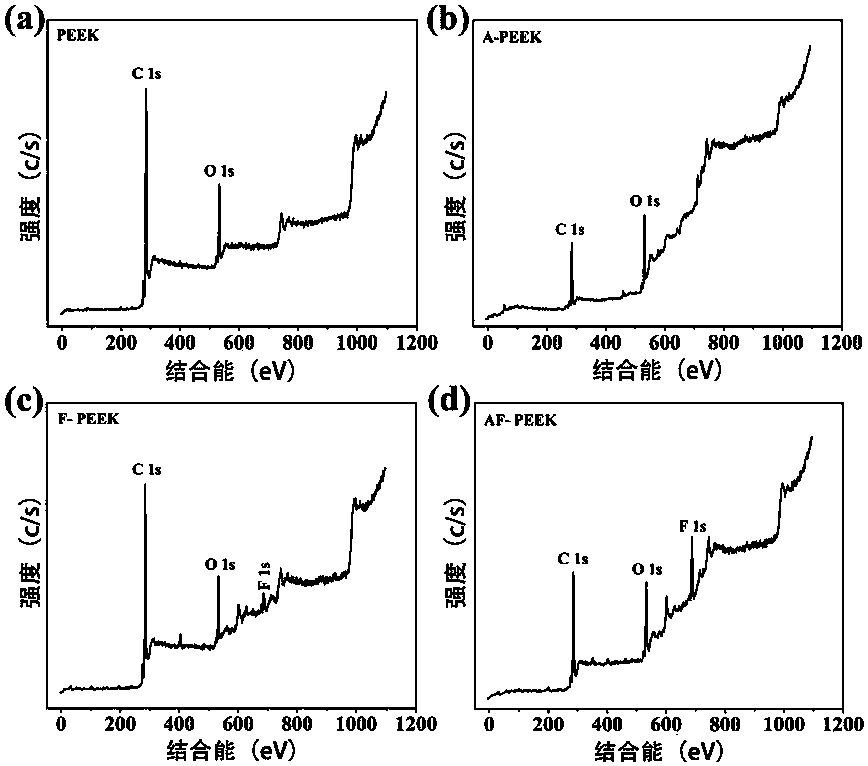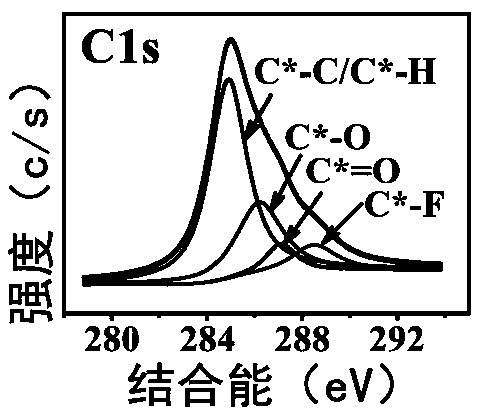Surface-fluorinated polyether-ether-ketone material and preparation method thereof
A polyetheretherketone and surface fluorination technology, which is applied in the field of surface modification of medical polymer materials, can solve the problems of inability to introduce fluorine elements and the like
- Summary
- Abstract
- Description
- Claims
- Application Information
AI Technical Summary
Problems solved by technology
Method used
Image
Examples
Embodiment 1
[0049] After the pure polyetheretherketone of 10mm×10mm×1mm is polished, it is ultrasonically cleaned with acetone and deionized water in sequence, each time for 30 minutes, after cleaning, it is dried in an oven at 80°C and stored properly. Firstly, plasma immersion ion implantation is performed on the polyetheretherketone substrate with argon gas as the ion source, and its specific process parameters are shown in Table 1 in Comparative Example 1; After soaking in 40% hydrofluoric acid aqueous solution for 24 hours, ultrasonically clean with deionized water for 3 times, 20 minutes each time. Dry the cleaned polyether ether ketone material (AF-PEEK) naturally and store it properly; figure 1 (AF-PEEK) is the surface morphology diagram of the medical polyether ether ketone material obtained through the modification treatment of this example, and the figure shows that the modified material surface retains a structure similar to that of A-PEEK; Figure 4 (AF-PEEK) is the contact ...
Embodiment 2
[0051] X-ray photoelectron spectroscopy (XPS) was used to evaluate the chemical state of the surface of the polyetheretherketone material obtained through the modification of Comparative Examples 1 and 2 and Example 1 above. The instrument used is the PHI 5000C ESCA System of the American PHI Company (upgraded by the American RBD Company); the ray source is the Mg target Kα system (1253.6eV), the high voltage is 14.0kV, the power is 250W, and the vacuum is better than 1×10 -8 Torr. The RBD147 data acquisition card and AugerScan software from RBD Company in the United States are used to collect the full scan spectrum of the sample at 0-1200eV and the narrow scan spectrum (high resolution spectrum) of the 1s orbital of carbon (C) and oxygen (O) elements;
[0052] figure 2 It is the X-ray photoelectron spectroscopy (XPS) test result of the surface of the polyetheretherketone material before and after the modification treatment of the present invention and the surface of the po...
Embodiment 3
[0054]The electrical state near the surface of the polyether ether ketone material obtained through the modification treatment of the above Comparative Examples 1 and 2 and Example 1 was evaluated by using the Zeta potential test on the surface of the material. The specific method is as follows: an electrokinetic analyzer (Anton Paar, Austria) is used to measure the Zeta potential of the diffusion layer near the surface of the material as a function of the pH value of the electrolyte. Take two samples of 20mm×10mm×1mm for each group of materials to be tested, and install them face-to-face and parallel on the sample holder, leaving a certain gap between the two samples. The electrolytic solution used is 0.001M potassium chloride solution, and the pH value of the electrolytic solution is adjusted with hydrochloric acid and sodium hydroxide aqueous solution. At each different pH value point, the instrument will measure the electrokinetic current, pressure, electrolyte constant an...
PUM
| Property | Measurement | Unit |
|---|---|---|
| size | aaaaa | aaaaa |
| quality score | aaaaa | aaaaa |
| quality score | aaaaa | aaaaa |
Abstract
Description
Claims
Application Information
 Login to View More
Login to View More - R&D
- Intellectual Property
- Life Sciences
- Materials
- Tech Scout
- Unparalleled Data Quality
- Higher Quality Content
- 60% Fewer Hallucinations
Browse by: Latest US Patents, China's latest patents, Technical Efficacy Thesaurus, Application Domain, Technology Topic, Popular Technical Reports.
© 2025 PatSnap. All rights reserved.Legal|Privacy policy|Modern Slavery Act Transparency Statement|Sitemap|About US| Contact US: help@patsnap.com



